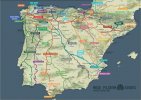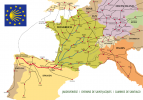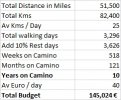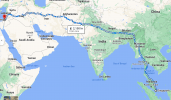I find that a bit of an unusual view. While we can discuss endlessly that a pilgrimage is not a hike, I see the ever increasing popularity of Camino walking evolve in parallel with the ever increasing popularity of outdoor walking during leisure time, at least around here where I live in the middle of the European continent. I wanted to read up a bit on data for my own pleasure but came instead across an article about the History of Walking (also known as
wandern, wandelen, randonner, and I don't know the Spanish
, is it
caminar?) and thought I'd share a bit of it (translated, see below).
Walking when you don't have to do so for your living became popular about 150 years ago, at the end of the 19th century. And isn't the last sentence in the quoted extract true? Ask yourselves: Would YOU be walking in Spain if there were no transcontinental airplanes to take you there?
The history of walking
People have always been on the move on foot - to open up new hunting grounds, to transport goods, to look for work, to find pastures for their cattle or to wage war against neighbouring peoples with entire armies.
For a long time, however, no one wandered just for fun. Walking was not a pleasure or a leisure activity, but a means to an end. And walking was part of the hard daily routine for those who could afford neither horse nor carriage.
That only changed about 150 years ago. In the middle of the 19th century, a means of transport was gaining ground that made it possible for broad sections of the population to get from one place to another faster than ever before: the railway.
People were no longer forced to do everything on foot - the way was paved for hiking as a conscious experience of nature.
People became more mobile. Sundays no longer had to be spent in one's own village or town. From now on, people could travel to places that would have been almost inaccessible without the railway.
 Thanks. I am really interested to make this dream comes true. Is the Camino walk hard? Do I need to train and prepare for it? Can I just do the on site training? I am in the midst of doing the last 100km of Camino Frances and Finisterre route starting today from Sarria. What is the highest elevation of Camino walk? Is that anything above 5000 meters above sea level? Thanks.
Thanks. I am really interested to make this dream comes true. Is the Camino walk hard? Do I need to train and prepare for it? Can I just do the on site training? I am in the midst of doing the last 100km of Camino Frances and Finisterre route starting today from Sarria. What is the highest elevation of Camino walk? Is that anything above 5000 meters above sea level? Thanks.




























